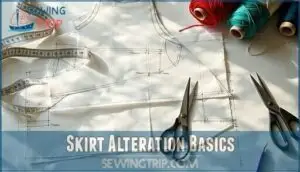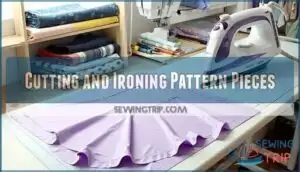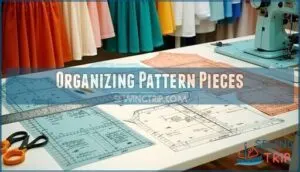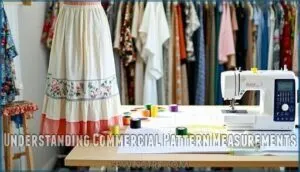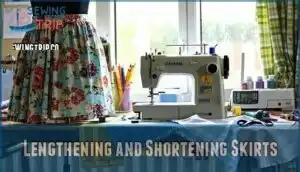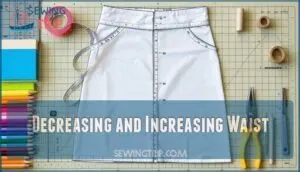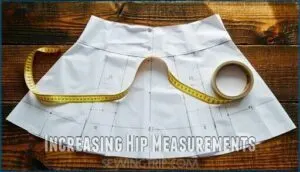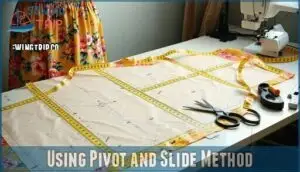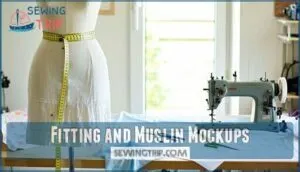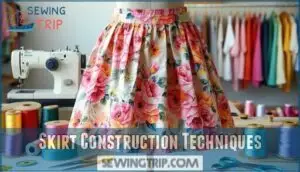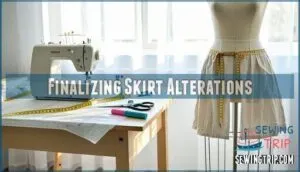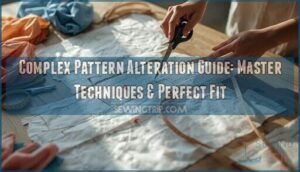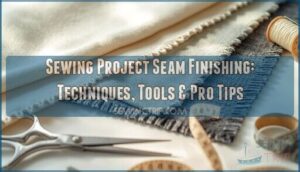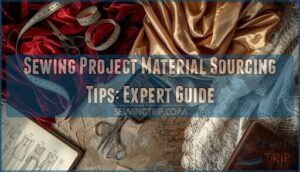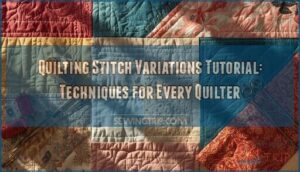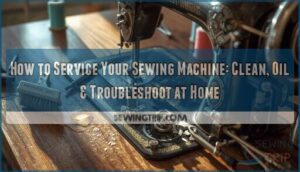This site is supported by our readers. We may earn a commission, at no cost to you, if you purchase through links.
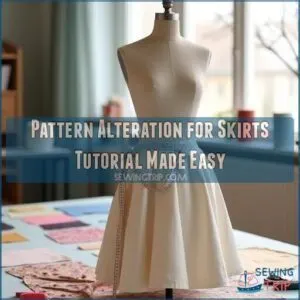 You’re looking for a pattern alteration for skirts tutorial to create a customized fit.
You’re looking for a pattern alteration for skirts tutorial to create a customized fit.
You’ll learn to adjust dart direction, waistlines, and hem lengths. Start by selecting the right pattern size and preparing your pieces.
Then, alter the pattern to fit your body, using techniques like pivoting and sliding. With practice, you’ll master the skills to create flattering silhouettes.
Next, you’ll discover how to finalize your alterations and achieve a perfect fit, and that’s where the real magic happens.
Table Of Contents
Key Takeaways
- You’ll master adjusting darts, waistlines, and hem lengths to create a customized fit that flatters your body shape.
- To alter a skirt pattern, you’ll use techniques like pivoting and sliding, which require practice and patience to get right, but will help you achieve a perfect fit.
- You’ll learn to make a muslin mockup to test your alterations, which is a crucial step in ensuring a great fit, and will help you identify and mark any necessary changes.
- By following the steps in this tutorial, you’ll be able to handle common alteration challenges, like uneven hemlines and waistline adjustments, with ease, and will be able to create a skirt that fits you perfectly.
Skirt Alteration Basics
You’re about to learn the basics of altering skirts, and it’s easier than you think.
Altering skirts is easier than you think, start with the basics
You’ll start by understanding how to change dart direction, redraw darts and waistlines, and create curved darts to achieve a perfect fit.
Changing Dart Direction
You can change dart direction for a skirt pattern alteration. Consider:
- Dart angle options
- Aesthetic dart placement
- Functional dart design
- Dart style variations
- Creative dart manipulation to achieve desired fit and look, exploring various dart manipulation techniques for skirt pattern adjustments.
Accurate adjustments require measuring high bust to ensure a proper fit, which is a crucial step in the alteration process, involving creative techniques for skirt pattern adjustments.
Redrawing Darts and Waistline
You’re altering a skirt pattern, focusing on redrawing darts and waistline.
| Method | Description |
|---|---|
| Dart manipulation | Reshape waistline |
| Waistline reshaping | Adjust skirt fit |
Use contouring methods for a perfect fit, considering dartless options.
Creating Curved Darts
You’re mastering dart manipulation.
To create curved darts, draw new lines ending at the old dart tip, adjusting the dart shape and curve placement to resolve fitting issues and explore style variations, a key design element in skirt pattern alteration.
This process allows for style variations, enabling you to refine your skills in skirt pattern alteration.
Cutting and Recutting Skirt Sides
Curved darts add shape, but what if you need more? Let’s talk about cutting and recutting skirt sides. This is where you really refine the shape.
Here’s how:
- Cut open the new dart.
- Close the old dart.
- Add paper to fill the gap.
- Recut the skirt side.
This maintains pattern integrity after side seam alterations. Recutting techniques and hemline adjustments are key to altering skirt for fit. This skirt alteration tutorial helps address skirt fitting issues.
Pattern Preparation Tips
You’re about to learn how to prepare your pattern for alteration, which is a key step in creating a custom-fit skirt.
By following these tips, you’ll be able to select the correct pattern size, cut and iron your pattern pieces, and organize them for easy use.
Selecting Correct Pattern Size
You select a correct pattern size by comparing your body measurements to the size charts.
Verify the pattern pieces have actual garment measurements, considering pattern ease for a good fit in your skirt pattern alteration, especially when working with sewing patterns fitting and skirt fitting.
Cutting and Ironing Pattern Pieces
You’ll work on a large, flat surface for accurate pattern layout and cutting accuracy.
Ironing techniques are key, so pre-wash and iron your fabric. Use pattern weights to hold things in place, ensuring the grainline is straight for your skirt pattern alteration in this sewing tutorial.
Many sewists find that using specialized sewing tools improves cutting accuracy and overall quality, making it a crucial step in the sewing process, especially for achieving a professional finish.
Organizing Pattern Pieces
You organize pattern pieces by leaving space between them and adding grainlines.
- Label each piece
- Include cutting instructions
- Store safely
- Use digital organization
To guarantee proper drape, understanding grainlines and notches is essential. Prioritize patterns for skirt alteration techniques, guaranteeing a smooth pattern modification process.
Understanding Commercial Pattern Measurements
When altering skirts, understanding commercial pattern measurements is key.
Commercial patterns use standard sizes, which may not fit individual body shapes.
Accurate measurement is essential, and alteration is often necessary for a good fit, making pattern grading and modification essential skills for sewing patterns alterations and skirt alterations.
Altering Skirt Patterns
You’re about to learn how to alter skirt patterns to achieve a perfect fit.
By following these steps, you’ll be able to make adjustments to the waist, hips, and length of your skirt pattern to create a custom-fit garment that flatters your body.
Lengthening and Shortening Skirts
You’re ready to alter your skirt’s length. Consider:
- Uneven hems
- Hem finishes
- Fabric choice
Lengthening or shortening skirts requires careful planning to maintain proportion balance, as seen in this skirt alteration guide, ensuring your skirt alterations turn out perfectly.
Many resources exist for skirt alteration projects, which can help with skirt alteration.
Decreasing and Increasing Waist
You adjust the waist by dividing changes by four, then split between seam and dart.
| Method | Description |
|---|---|
| Waist Adjustment | Math guides changes |
| Blending | Seam lines smoothly |
| Dart Manipulation | Follows specific rules |
Increasing Hip Measurements
You’ll increase hip measurements by blending seams and making curve adjustments.
To modify your skirt pattern, add ease where needed, considering fabric and fitting challenges, especially for hip adjustments, allowing for a smooth skirt alteration and pattern modification process.
This process involves careful consideration of the fabric and the fitting challenges to ensure a smooth skirt alteration.
Using Pivot and Slide Method
You’ll master the pivot and slide method with these steps:
- Identify the pivot point
- Slide the pattern
- Adjust the waist
- Blend the hip
- Check symmetry, ensuring accurate body measurements are essential for a perfect fit in your skirt pattern alterations, which involves a careful adjustment.
Fitting and Muslin Mockups
You’re now going to learn how to fit and create muslin mockups for your skirt pattern.
Mastering muslin mockups ensures a perfect skirt fit every time
By trying on a muslin mockup, you can identify and mark the alterations you need to make, ensuring a perfect fit for your final skirt.
Creating Muslin Mockups
You create muslin mockups to test skirt pattern alterations.
| Muslin Fabric Choice | Mockup Seam Allowance | Fitting Ease |
|---|---|---|
| Cotton | 1/4 inch | Loose |
| Polyester | 1/2 inch | Fitted |
| Linen | 1/4 inch | Flowy |
| Rayon | 1/2 inch | Tight |
The table provides details on mockup seam allowance and fitting ease for different muslin fabric choices.
Trying on Muslin Mockups
You try on the muslin mockup to assess the fit, ensuring seam access for alterations.
A snug fit is key, allowing you to sketch alterations and make a durable mockup for skirt pattern alterations, achieving muslin fitting ease.
Marking Alterations With Iron-Off Pens
When marking alterations with iron-off pens, consider pen mark visibility and fabric type, as heat setting marks can be permanent, making removing pen marks difficult, affecting accuracy in skirt pattern alterations and pattern modification, guiding sewing patterns modifications and adjustments for better fit.
Addressing drag lines and pulling can resolve fit issues, and this step is crucial for achieving a better fit through pattern modification.
Trimming Muslin to Desired Shape
You trim your muslin to the desired shape, refining the fit.
Accurate shape transfer is key. Consider seam allowances and blend altered lines for a durable muslin pattern.
Essential for skirt pattern alterations and modifications in this skirt tutorial, using muslin trimming tips for perfect pattern alterations, with accurate shape transfer being crucial.
Skirt Construction Techniques
You’re now moving on to skirt construction techniques, where you’ll learn to create facings, waistbands, and add embellishments.
By following these steps, you’ll be able to construct a well-fitted skirt that meets your needs and preferences.
Creating Facings and Waistbands
When altering skirt waist, you’ll make a facing by drawing a shape onto the skirt pattern.
Cut a waistband, then iron fusible interfacing to the wrong side for reinforcement, ensuring a sturdy waistline adjustment.
Properly close the dart for a smooth facing application.
Adding Embellishments and Seaming
You’re adding embellishments and seaming to your skirt.
Explore seam detailing, embellishment types, and fabric manipulation techniques.
Use decorative stitching for texture contrast, considering seam allowance for a polished finish, and discover various sewing techniques and tutorials for perfecting your skills with embellishments.
Using Dress Forms for Fitting
When you modify skirt pattern, a dress form can be a great help. However, adjustable forms present fitting challenges.
Here’s how to improve your custom skirt fit:
- Use accurate measurements.
- Consider DIY dress forms.
- Explore different dress form types.
- Pin fabric to adjust skirt pattern for skirt pattern fitting.
A dress form aids in pinning. Many sewers also utilize specialized fitting tools like dress form skirts to achieve a better custom skirt fit.
Applying Fusible Interfacing
You’re applying fusible interfacing to stabilize waistbands.
| Interfacing Types | Fabric Compatibility |
|---|---|
| Fusible | Cotton, Polyester |
| Sew-in | Silk, Wool |
Use it to reinforce waistbands, ensuring durability and a professional finish in sewing pattern alteration.
Finalizing Skirt Alterations
You’re almost done with your skirt alteration, and now it’s time to finalize the changes.
You’ll double-check your math, make any last adjustments, and perfect the fit with a muslin mockup to guarantee your skirt turns out just right, ensuring a perfect fit.
Mathematical Checks for Alterations
Accuracy is key in skirt pattern making. Mathematical checks guarantee your skirt alteration hits the mark. Don’t skip this step!
Here’s your checklist:
- Verify Waist Division.
- Confirm Hip Calculation.
- Check Dart Adjustment.
- Include Seam Allowance.
These checks maintain Pattern Proportions. Double-checking prevents errors. You’ll avoid frustration in skirt drafting. It’s like measuring twice and cutting once, but for skirt pattern drafting, which requires Accuracy and Mathematical checks.
Experimenting With Embellishments
You’ll often experiment with embellishments like Bead Placement, Sequin Application, or Fabric Painting to enhance your skirt design.
Consider Trim Selection and Texture Mixing to add depth.
This creative process is key to skirt pattern making and modification, allowing you to personalize your sewing patterns alteration with complete concepts.
Perfecting Fit With Muslin Mockups
You perfect the fit with a muslin mockup, testing seam allowance and pinning techniques.
This iterative fitting process helps transfer alterations to your skirt block, ensuring accurate fit adjustments in your sewing pattern fitting, especially for a test garment like a muslin skirt.
Resizing Patterns for Custom Fit
To resize patterns for a custom fit, consider these steps:
- Measure accurately
- Apply grading techniques
- Adjust proportions.
Muslin fitting guarantees measurement accuracy, allowing for proportion adjustment and pattern scaling, making sewing pattern adjustments and modifications easier for skirt pattern drafting and waist adjustments.
It is crucial to note that muslin fitting is a key step in this process.
Frequently Asked Questions (FAQs)
Why do I have to make alterations if I’m sewing my own wardrobe?
You’ll make alterations because commercial patterns rarely fit individual body shapes, and small changes guarantee a great fit, making your self-sewn garments comfortable and flattering.
How do you change a skirt waist?
You’ll lower or raise the waistline by desired amount, taking in or adding 5-1cm at the new waistline, and adjust sides and darts accordingly for a custom fit.
Do you need a pencil skirt pattern alterations?
You’ll need pattern alterations for a pencil skirt if it doesn’t fit your body, so take your measurements and adjust the pattern accordingly for a perfect, customized fit.
How to make a skirt overlapping?
You’ll overlap skirt pieces, then pin and sew them together, creating a seamless joint, and finally, topstitch for a polished finish, ensuring a professional-looking overlap.
How to make an A-line skirt from a straight skirt?
You’ll close the dart, opening volume at the hemline, to create an A-line skirt from a straight one, giving you a flattering, flowing silhouette with ease.
How do you re-cut a skirt?
You re-cut a skirt by adjusting the pattern, adding or removing darts, and altering the waistline or hem to achieve a perfect fit and desired shape.
What are the steps in drafting a pattern for a skirt?
You’ll draft a skirt pattern by selecting a size, cutting pieces, and ironing them, then making adjustments as needed to achieve a perfect fit and desired silhouette.
How to make pattern adjustments?
You’ll make pattern adjustments by altering darts, waistlines, and hems, using techniques like pivoting, sliding, and blending to achieve a custom fit that flatters your body shape perfectly.
How to make a skirt for beginners step by step?
You’ll start by measuring your waist and hips, then use a pattern or create your own to sew a fantastic, flattering skirt that fits you perfectly, every time, with ease.
How to handle uneven skirt hemlines easily?
You’ll easily handle uneven skirt hemlines by using a ruler or measuring tape to mark even lengths, then trimming excess fabric for a flawless finish.
Conclusion
Now you’re altering skirts like a pro, mastering the pattern alteration for skirts tutorial with ease.
You’ve learned to adjust darts, waistlines, and hem lengths, creating a customized fit.
With this pattern alteration for skirts tutorial, you’ll make flattering silhouettes, achieving a perfect fit with practice and patience, making you a skilled skirt alterer.

